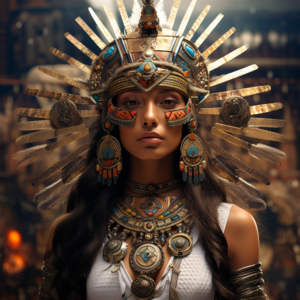Chantico is a revered goddess in Aztec mythology, known for her association with fire, hearth, and volcanoes. Her origins can be traced back to ancient Aztec beliefs, where she emerged as a central figure embodying the transformative and destructive powers of fire.
Appearance
Chantico is often depicted as a beautiful goddess adorned with jewels, representing her status as a deity of wealth and abundance. She is portrayed with a distinctive headdress and elaborate garments, signifying her connection to fire and the sacred hearth. Chantico’s depiction reflects her dual nature as a provider and destroyer.
Powers & Abilities
As the goddess of hearth and volcanoes, Chantico possesses a range of powers and attributes linked to fire and its transformative nature. She is associated with the hearth fire, representing domestic warmth, cooking, and the social bonds of family and community. Chantico’s powers extend to the volatile and destructive forces of volcanic eruptions, symbolizing the immense power of nature.
Chantico’s association with the sacred hearth holds great significance in Aztec culture. The hearth fire was central to daily life, providing warmth, nourishment, and protection. Chantico is honored as the guardian of the hearth, and offerings and rituals are made to appease her and ensure the blessings of a well-tended and harmonious household.
Chantico’s connection to volcanoes highlights her role in the realm of fiery eruptions and destructive forces of nature. Volcanoes were seen as portals between the earthly and divine realms, and Chantico was believed to unleash her wrath through volcanic eruptions. These cataclysmic events were viewed as both a source of fear and awe, underscoring the power and unpredictability of Chantico.
SYMBOLS
Symbols associated with Chantico include flames, representing the transformative and destructive aspects of fire. The sacred hearth is also a significant symbol, symbolizing the warmth, nourishment, and communal bonds fostered through Chantico’s presence. Additionally, volcanic imagery and representations of erupting volcanoes serve as reminders of Chantico’s power and influence.
Worship
The worship of Chantico involved various rituals, ceremonies, and offerings dedicated to her. These practices aimed to honor and appease the goddess, seeking her blessings and protection in matters related to the hearth, family, and the transformative power of fire.
One aspect of Chantico’s worship involved the tending of hearths and fireplaces. Devotees would maintain a sacred fire in their homes, symbolizing Chantico’s presence and offering a connection to the divine. The fire was tended with care and respect, as it was believed to bring warmth, light, and purification to the household.
Offerings were an integral part of Chantico’s worship. These offerings often included symbolic objects such as food, flowers, and incense. The offerings were presented to Chantico as a gesture of gratitude and reverence, seeking her favor and blessings in matters related to the home, family, and daily life.
Ceremonies and rituals were performed in temples dedicated to Chantico. These sacred spaces provided a gathering place for devotees to come together, offer prayers, make offerings, and participate in rituals dedicated to the goddess. Priests and priestesses played a vital role in leading these ceremonies and guiding the worshippers in their devotion to Chantico.
Symbolic representations of Chantico, such as statues or images, were present in temples and households dedicated to her worship. These representations served as focal points for devotion and a means to connect with the presence and power of the goddess.
The worship of Chantico reflected the Aztec understanding of fire as a transformative and purifying force. It emphasized the importance of the hearth and home, as well as the nurturing and protective aspects associated with Chantico’s domain.
Fascinating Facts about Chantico
- Chantico’s name translates to “She Who Dwells in the House,” emphasizing her connection to the domestic sphere and the hearth fire.
- Chantico was also associated with the consumption of spicy foods and chocolate, as they were believed to possess fiery and transformative qualities similar to her nature.
- Chantico was sometimes depicted as a four-faced deity, each face representing a different aspect of her fiery powers.
- In some myths, Chantico is linked to the deity Xiuhtecuhtli, the god of fire and life, symbolizing the complementary and intertwined forces
- Chantico’s mythology often intertwines with stories of creation and destruction, emphasizing her role as a catalyst for change and renewal.
- Chantico’s wrath was believed to be a consequence of disrespecting or neglecting the sacred hearth, highlighting the importance of maintaining harmonious domestic life and honoring the divine.
- Chantico’s influence extends beyond the realm of domesticity and volcanoes, as she is also associated with transformation and rebirth, symbolizing the transformative power of fire in shaping and renewing life.






